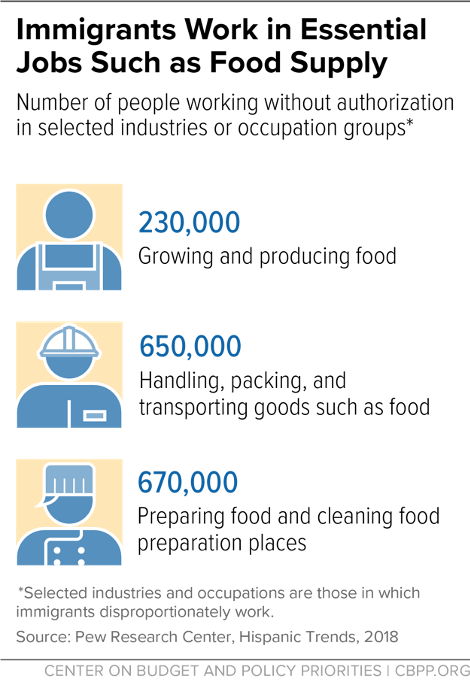The Coronavirus Aid, Relief, and Economic Security (CARES) Act included stimulus rebates to provide income support and shore up overall consumer demand to offset some of the downward economic pressure from the COVID-19 pandemic and public health response. With the nation facing a deep and possibly prolonged downturn, including a double-digit unemployment rate the Congressional Budget Office projects for most of 2021, policymakers are reportedly giving serious consideration to an additional round of stimulus payments. Any subsequent round of payments should fill gaps left by the CARES Act rebates and their implementation. In particular, it should extend rebates to people with modest incomes who were previously left out — an estimated 15 million people in immigrant families and 15 million older children and adult tax dependents.
To be eligible for the rebates under the CARES Act, every person on a household’s tax return must have a Social Security number (SSN); if a parent has an SSN and the children in the household do as well but the other spouse on the tax return lacks an SSN, the entire household is disqualified. This rigid rule excludes millions of immigrants and their citizen children, many of whom are working on the front lines in the pandemic, providing health care, delivering food, or caring for vulnerable elderly people. Other immigrant workers were employed until very recently in economic sectors that now are being hit by mass layoffs. Among those left out are an estimated 5 million children, who would otherwise qualify for a $500 rebate; over 85 percent of these children are U.S. citizens.[1] Policymakers should recognize the contributions of these immigrant workers to their communities and the economy — and should include, rather than exclude, these people going forward.
The CARES Act rebates also exclude 17- and 18-year-old children, as well as college students, who are tax dependents — and other adult dependents, such as adult children with serious disabilities. They, too, should be included.
These groups should be among the beneficiaries of any future rounds of rebates. Congress also should consider amending the stimulus payments provisions of the CARES Act to make these people eligible for the first round of rebates as well. And any new round of rebates should be designed so that, to the fullest extent possible, the rebates are delivered automatically and without burdensome filing requirements.
These steps would build on those the CARES Act took. The design of the stimulus rebates in that Act was a major improvement in one important respect over the 2008 stimulus payments on which they were modeled — this time, there is no minimum earnings threshold so the lowest-income people are eligible for the full rebate amount. The poorest adults can receive the same $1,200 as middle-class adults, and children living in deep poverty can receive the same $500 as middle-class children.
The CARES Act also improved on the 2008 rebate in another way. In 2008, about 3.5 million senior citizens lost out on the stimulus rebates because they either didn’t know they first had to file a tax return or couldn’t overcome that process’s hurdles. This time, lawmakers gave the Treasury Department the authority to deliver stimulus rebates automatically to people who normally don’t file a tax return, including recipients of Social Security, railroad retirement, Supplemental Security Income (SSI), and certain veterans benefits. The IRS, Social Security Administration (SSA), and Department of Veterans Affairs (VA) should be commended for using this authority — after initial indications to the contrary — so that Social Security, railroad retirement, SSI, and certain veterans benefit recipients will receive their payments automatically. The next stimulus bill should mandate, rather than just authorize, automatic payments for these groups, and policymakers should also consider delivering automatic payments to other low-income households that aren’t otherwise required to file tax returns, using information that states have on SNAP (food stamp) and Medicaid beneficiaries.
Finally, Congress should provide additional funds to the IRS — and for the Volunteer Income Tax Assistance (VITA) program — so that any subsequent stimulus payments can be provided as rapidly as possible and so much-needed outreach can be conducted to get the payments to impoverished people who don’t ordinarily file tax returns. IRS staff have shown outstanding commitment and public service in this crisis, but a decade of budget cuts has left the IRS severely depleted and often relying on archaic systems. Once the crisis subsides, the Congress should commit to a multi-year effort to rebuild this core function of government.[2]
The CARES Act includes “recovery rebates” of $1,200 per adult ($2,400 for a married couple) and $500 per dependent child aged 16 or younger.[3] A married couple with two children is therefore eligible for a $3,400 payment. The rebates phase down gradually for married couples with incomes above $150,000, heads of household with incomes above $112,500, and individuals with incomes above $75,000. (Married couples with two children and incomes above $218,000, heads of households with two children and incomes above $156,500, and single individuals with incomes above $99,000 are not eligible for a rebate payment). The rebates are larger than the 2008 stimulus payments of $600 for a single filer, $1,200 for a married couple, and an extra $300 per child (around $740, $1,490, and $371, respectively, in 2020 dollars).
Unlike the 2008 payments, households don’t need a minimum level of income or earnings to qualify. An earlier proposal from Senate Majority Leader Mitch McConnell would have provided only a partial rebate to nearly 70 million households with incomes below about $50,000 and would have left out roughly 9 million very low-income households entirely.[4] That proposal met swift bipartisan opposition, however, including from Republican Senators Mitt Romney and Josh Hawley, as well as from many Democrats, and these restrictions on low- and modest-income households were dropped during subsequent negotiations on the legislation.[5]
With millions of low-income people receiving the same amount as people above them on the income scale, rather than less, the rebates will be more effective in reducing financial hardship and protecting the economy from an even deeper hit. Low-income people are more vulnerable during a severe downturn: they are likelier to see their earnings fall and much less likely to have a financial cushion to rely on. And, because low-income people have tight budgets, they are more likely to spend rather than save virtually every added dollar of income, so getting resources into their hands also is highly effective in reducing the decline in consumer spending, which is vital for the economy.
While the CARES Act is an improvement over the 2008 stimulus rebates, it misguidedly denies the rebate to certain families with immigrants — including many with children who are U.S. citizens — and to tens of millions of dependents over the age of 16.
For a household to receive any rebate, each adult and spouse, if married filing jointly, must have a Social Security number. (The only exception is for members of the armed services, if one spouse has an SSN.) That means that the entire household — including the children in it — is denied any stimulus payment if either the filing adult or spouse lacks an SSN. In addition, children must have an SSN to qualify for the $500 additional payment. This means that the CARES Act leaves out:
- All adults who lack an SSN, even if their children have SSNs or their spouse has an SSN and they file jointly;
- All adults who have an SSN but whose spouse lacks one (if they file jointly);
- Children who don’t have SSNs, including children who are undocumented, children who are in the application process for certain immigration statuses, and young people who have met the requirements for Deferred Action for Childhood Arrivals (DACA) but have not yet obtained an SSN; and
- Children who have SSNs — including large numbers of U.S. citizen children — if one or both of their parents lacks an SSN.
As a result, the stimulus payments leave out more than 15 million people in low- and middle-income immigrant families who would receive a full rebate were it not for this bar. This includes about 5 million children under 17, about 7 out of 8 of whom are U.S. citizens.[6]
This treatment is harsher than the new, more restrictive SSN requirements for the Child Tax Credit enacted as part of the 2017 tax law. While that law denied the tax credit to about 1 million previously eligible children who lack an SSN, it allows children with SSNs to receive the credit irrespective of whether one or both of their parents may lack an SSN.[7]
The underlying rationale for the stimulus rebates — to get cash quickly to families and individuals who are likely to be harmed financially by the pandemic and who will spend the additional resources and thereby help prop up the economy — applies just as much to immigrants and their families as to others. Parsing immigration status during an acute pandemic and economic crisis not only will deny help to many of the hardest-hit families, children, and communities but also is unwise from an economic standpoint.
Moreover, the immigrant workers left out of the rebates are concentrated in many of the most essential jobs right now and often are more exposed to infection. According to the Pew Hispanic Trends Project, people who aren’t authorized to work (because either their presence in the country or their work status is unauthorized) make up a disproportionate share of those who grow and produce food (230,000 workers); who handle, package, or transport goods within communities or around the country (650,000 workers); or who prepare food and keep food preparation places clean (670,000 workers).[8] (See Figure 1.)
In addition, our own estimates, based on Census data, suggest that an average of at least 170,000 undocumented immigrants and family members in low- and middle-income families worked in health care support occupations in 2015 through 2017.
Many of these workers don’t have the privilege of working from home and don’t receive paid leave benefits or other labor protections. Many have lost, or may soon lose, their jobs but won’t qualify for unemployment benefits. Others are facing health risks to continue providing essential goods and services to communities across the nation. Two-thirds of all such workers have lived in and contributed to the United States for more than a decade.[9]
Too often in normal times, lawmakers take for granted the contributions that immigrants and their families make. This health and economic crisis should make policymakers realize how heavily communities and the economy rely on immigrants and why they shouldn’t artificially exclude them from efforts to soften the pandemic’s economic blow. We recommend providing stimulus payments to households who have Individual Tax Identification Numbers — which many immigrant workers who lack an SSN use to file tax returns — on the same basis as other households. At a minimum, the payments should be available to any adult or child in a household who has an SSN.
The CARES Act provides a rebate of $500 per child dependent under age 17. Other tax dependents, however — including adult children with disabilities who live with family members who care for them, elderly individuals who depend on assistance from family members, and high school and college students over age 16 — are left out. We estimate that this leaves out more than 15 million lower- and middle-income dependents aged 17 and over who would receive a rebate were it not for this age restriction. These dependents include:
- about 5 million 17- and 18-year-olds;
- nearly 4 million college students aged 19 to 23;
- about 400,000 children aged 19 and older with disabilities; and
- more than 5 million other adult relatives (such as elderly parents) who have little income and are claimed as tax dependents by their children or other relatives.[10]
There is no clear policy rationale for omitting these dependents. Two explanations from Michael Zona, a spokesman for Senate Finance Committee Republicans, are weak.[11] First, he argued such rebates would be poorly targeted, saying that, “Dependents, by definition, aren’t responsible for a majority of their financial support,” and that, “The goal of the recovery rebates is to provide support for Americans who are responsible for their own financial well-being or that of another during this pandemic.” But this is not a strong justification for denying the rebates to these dependents while providing it to dependents under age 17. Moreover, Zona blamed the rush of the legislation, noting that, “Legislation is never perfect and always involves trade-offs,” and, “That is especially true of emergency legislation in the midst of a crisis. Using existing mechanisms already in place saves time when every moment matters.” But the CARES Act could have used an alternative, existing definition of dependents in the Internal Revenue Code[12] that would have allowed the inclusion of these millions of dependents. In any event, policymakers should close this gap in the next legislative vehicle.
After early indications that the Trump Administration would issue payments contingent on tax filing from certain groups who normally don’t file — including many Social Security, railroad retirement, and SSI beneficiaries, and recipients of certain veterans benefits — Treasury clarified that it will use its authority to provide the stimulus payments automatically to these groups.[13] Congress should mandate a continuation of this practice in subsequent rounds of stimulus payments.
In addition, the mechanisms for providing the stimulus payments to people eligible for them can be further improved. We recommend:
- Allowing recipients of federal benefits (i.e., Social Security, SSI, veterans benefits, and the like) who qualify for automatic stimulus payments to receive the $500 for their child dependents if they fill out the IRS form for non-filers at some point this year. Treasury is currently taking the position that people who receive Social Security, SSI, and certain VA benefits and who receive automatic payments for themselves but not their dependent children will have to wait until they file a tax return next year (for 2020) to receive those dependents’ payments.[14] This seems counter to the statute’s directive that payments be issued “as rapidly as possible.” The Administration should reconsider this position,[15] and Congress should clarify this issue in its next legislative vehicle.
- Requiring automatic delivery to children who receive federal benefits. Many minor children receive federal benefits themselves — most often Social Security benefits or SSI benefits for disabled children. Although most of these children are claimed as dependents on another person’s tax return (who would therefore qualify for a $500 payment for the child), some of these children are part of households that do not file tax returns. Those households will receive only a partial stimulus payment (if an adult in the household receives federal benefits) — or no payment at all (if no adults in the household receive federal benefits) if they don’t complete the online IRS form. In the next legislative vehicle, lawmakers should direct the IRS to make automatic stimulus payments to these children, using the same delivery mechanism by which the children receive their monthly federal benefit payments.
- Working with states to fill gaps. Requiring the federal government to share data with states on who has received stimulus payments, based on information from IRS, Social Security, and VA information, would help states identify who hasn’t received a payment but should be eligible. The states are well-placed to assist with populations who don’t file tax returns but receive benefits from state-administered programs such as SNAP or Medicaid. If a state has data from the federal government identifying to whom it has sent a stimulus payment, the state can determine which of its SNAP or Medicaid recipients have not received a payment. At the very least, states could help with targeted outreach to these low-income individuals, using funds appropriated in a future stimulus bill, to encourage them to file as needed to receive the payment.
-
Reaching people in need in Puerto Rico. Given the longstanding economic difficulties in Puerto Rico, which have been exacerbated by the natural disasters of recent years, efforts are needed there to deliver rebates to all who are eligible. Because Puerto Rico maintains its own tax system, its Treasury Department will distribute the payments under a plan that the U.S. Treasury approved on May 1. Puerto Rico’s Treasury Secretary has publicly stated, however, that his agency is still in conversations with the federal government about certain aspects of the approved plan, and the Commonwealth’s Resident Commissioner has called on the federal government to make payments directly to Social Security beneficiaries living in Puerto Rico.[16]
The U.S. Treasury and Puerto Rico should work out arrangements that maximize automatic payments for residents of the Commonwealth. Requiring people to file for their rebates risks leaving out many who need them the most. Many non-filers in Puerto Rico are very low-income individuals with little or no access to the internet (or to help with completing even a simplified online form of the sort that the Puerto Rico Treasury is reportedly developing). To reach as much of this population as possible, the federal government should disburse payments directly and automatically (i.e., without requiring the filing of a tax return) to Puerto Rico residents who are beneficiaries of Social Security or certain veterans payments. Puerto Rico’s government should be able to reach many others using platforms such as its Nutrition Assistance Program, which serves about two-fifths of the Commonwealth’s population.[17] Of course, not all of the non-filing population will be able to receive the payments automatically, so the Puerto Rico Treasury should also undertake strong outreach efforts to ensure that low-income households receive these funds and get them on a timely basis.
- Funding VITA. No matter how comprehensive Congress makes its directives to Treasury, some people will still need to file a tax return or risk falling through the cracks. For example, many low-wage childless adults receive little or no Earned Income Tax Credit, are not required to file a tax return, and do not do so. Robust outreach is needed to reach them, and VITA — the Volunteer Income Tax Assistance program, a federally supported network of IRS-trained volunteers who provide free tax-filing assistance to low-income filers — is well-placed to help. We recommend that additional federal funding be provided for VITA to help with this effort. The CARES Act did include additional appropriations for IRS Taxpayer Services to cover costs associated with disbursing the first round of payments but did not specifically allocate any of those funds to VITA.
- Funding the IRS. Finally, while the IRS has done an admirable job to date with the massive task of administering the rebates, decade-long budget cuts have left it with severely depleted staff and archaic computer systems.[18] Congress should provide additional funds now and should also commit to rebuilding the IRS in the years ahead.






